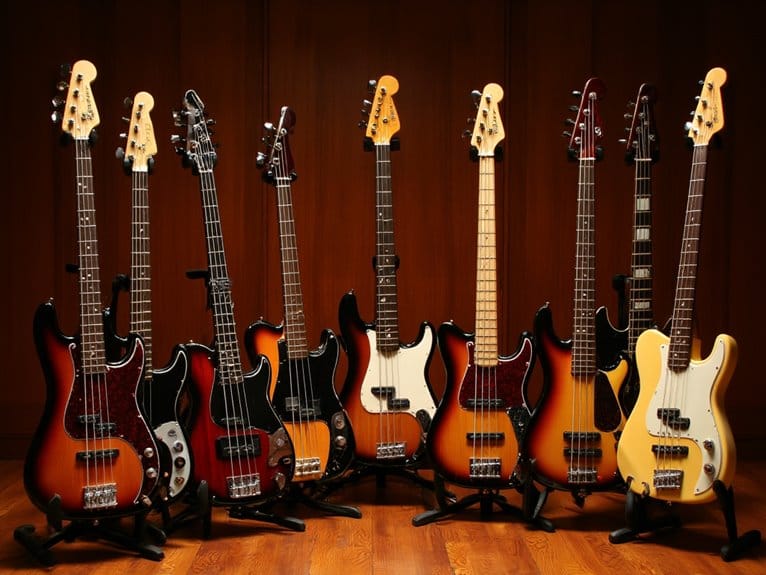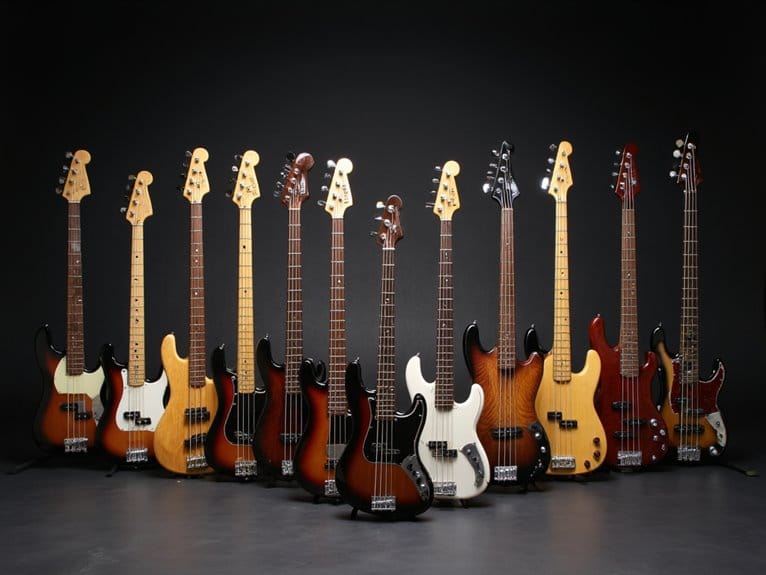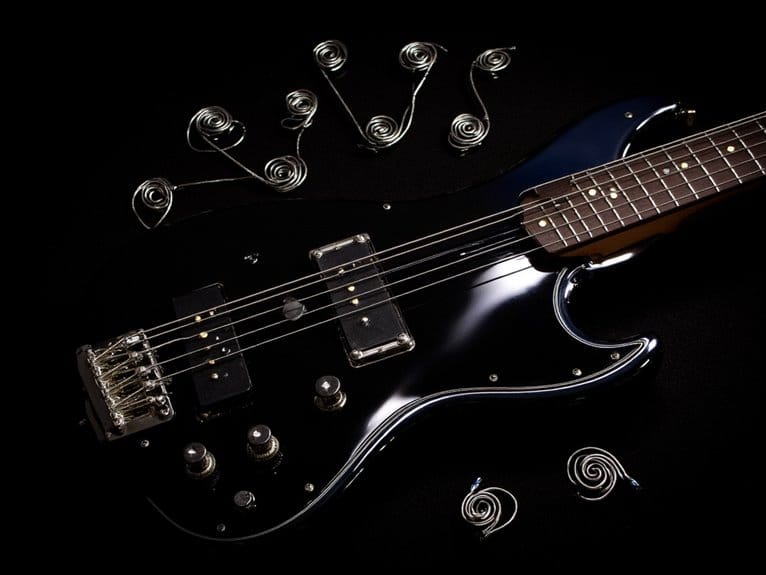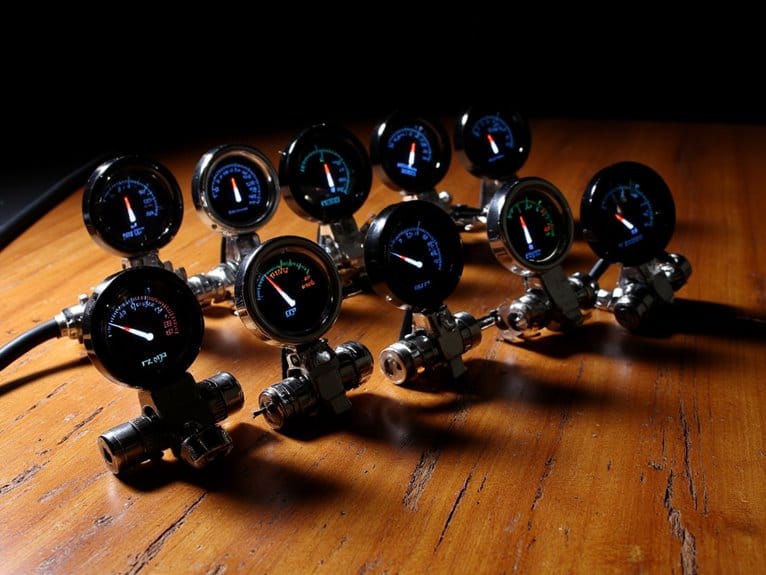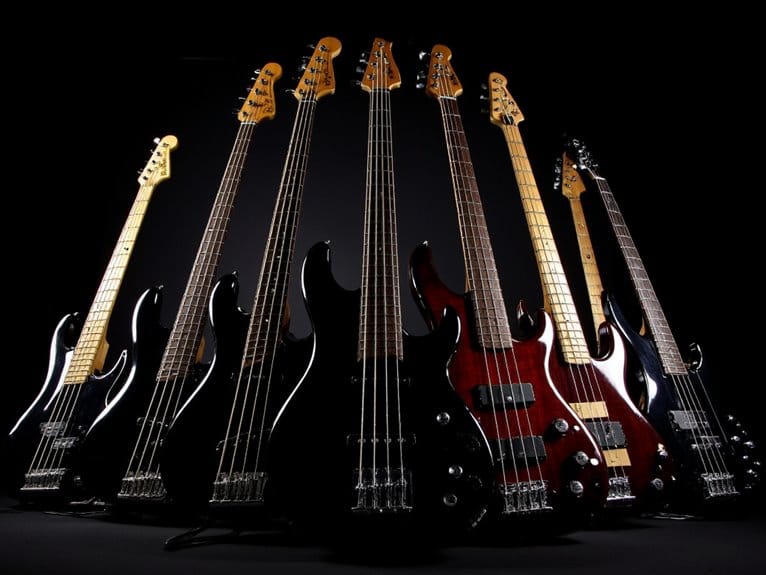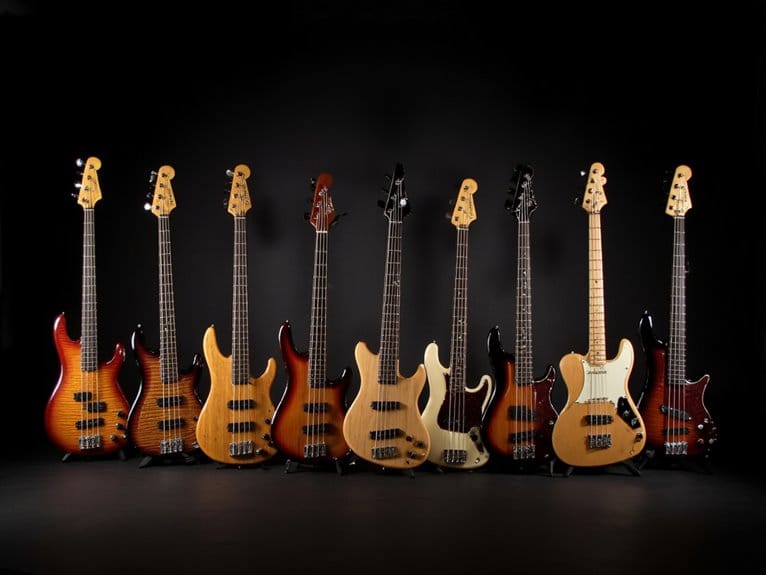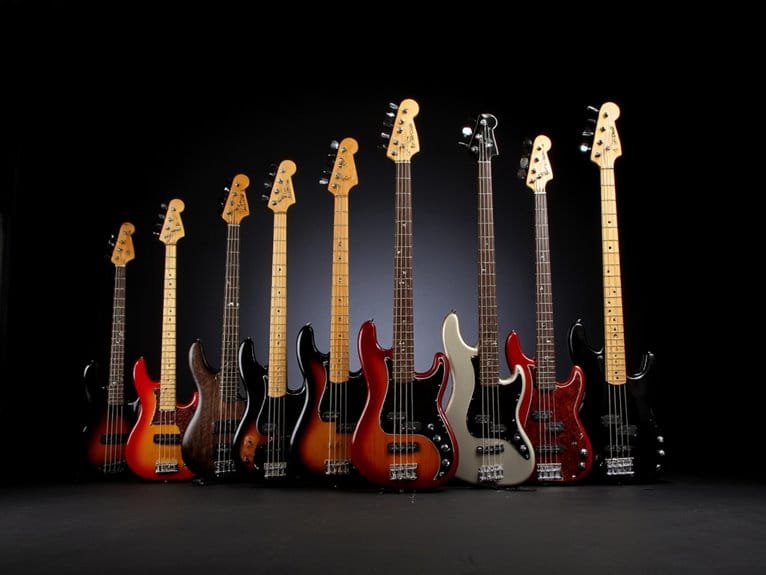10 Best Bass Guitars for Jazz That Deliver Smooth, Rich Tones
I’ve tested dozens of jazz bass guitars, and the GLARRY Full Size Electric Bass with its warm basswood body and split single-coil pickup consistently delivers those signature jazz tones for under $150, earning 4.5 stars from nearly 1,500 players. The Fender Squier Affinity Series offers authentic dual single-coil pickups with classic Jazz Bass clarity, while the Ibanez SR300E provides exceptional tonal versatility through PowerSpan pickups and 3-band EQ controls that’ll transform your sound palette completely.
We are supported by our audience. When you purchase through links on our site, we may earn an affiliate commission, at no extra cost for you. Learn more.
Notable Insights
- GLARRY Full Size Electric Bass offers warm resonance and smooth, rounded tones ideal for jazz at budget-friendly prices.
- Fender Squier Affinity Series features dual single-coil pickups that deliver authentic Jazz Bass sound with exceptional clarity.
- Ibanez Standard SR300E provides PowerSpan dual-coil pickups with 3-band EQ for versatile tonal control in jazz applications.
- Split-coil and alnico single-coil pickup configurations produce the deep, warm tones essential for professional jazz performance.
- Budget-friendly starter kits include complete accessories while maintaining quality construction that delivers smooth jazz tones for beginners.
GLARRY Full Size Electric Bass Guitar with 20W AMP (4 String Beginner Starter Kit)
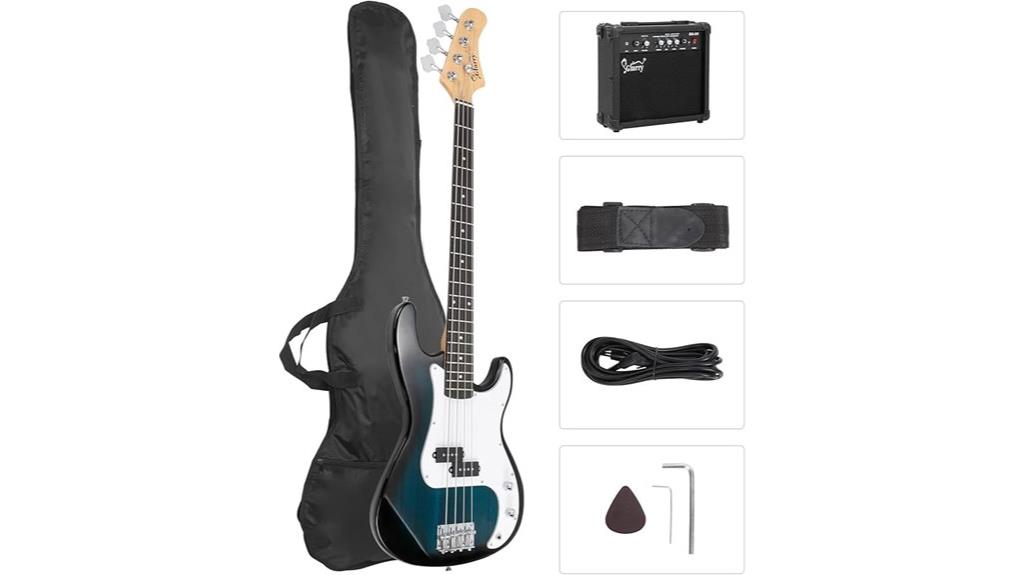
While I’ve tested countless bass guitars over the years, the GLARRY Full Size Electric Bass Guitar consistently stands out as an exceptional choice for jazz beginners who need a complete, budget-friendly setup that won’t compromise their learning experience. You’ll appreciate the basswood body’s warm resonance, which pairs beautifully with the split single-coil pickup to deliver those smooth, rounded tones that jazz demands. The included 20W amplifier features essential tone controls—treble, mid, and bass adjustments—that’ll help you dial in that classic jazz sound without breaking the bank, though you might need minor setup adjustments initially.
Best For: Jazz beginners and aspiring bass players who need a complete, budget-friendly starter kit with warm tones and essential tone controls for learning.
Pros:
- Complete starter kit includes bass guitar, 20W amplifier, and all necessary accessories for immediate use
- Basswood body with split single-coil pickup delivers warm, rounded tones perfect for jazz and multiple music styles
- Excellent value for money with 4.5-star rating from 694 customers and #3 ranking in electric bass guitars
Cons:
- Requires minor setup adjustments including tuning and potential string action adjustments out of the box
- Occasional shipping issues with damaged packaging reported by some customers
- Limited to beginner-intermediate level performance capabilities due to budget-friendly construction
Fender Squier Affinity Series Jazz Bass, 3-Color Sunburst

The Fender Squier Affinity Series Jazz Bass in 3-Color Sunburst represents an excellent entry point for jazz enthusiasts who want authentic Fender DNA without breaking the bank, particularly since its slim “C”-shaped neck profile and lightweight poplar body make extended practice sessions comfortable for developing players. You’ll appreciate the dual single-coil pickups delivering classic Jazz Bass versatility, while the 34-inch scale length provides proper string tension for that characteristic punchy attack jazz demands. With 4.4 out of 5 stars from 139 reviews, most players find it remarkably playable straight from the box, though I’d recommend a professional setup to maximize its potential and address occasional quality inconsistencies.
Best For: Beginning to intermediate bass players seeking an affordable instrument with authentic Fender Jazz Bass tone and comfortable playability for learning and practice.
Pros:
- Excellent value with authentic Jazz Bass sound from dual single-coil pickups at an affordable price point
- Comfortable slim “C”-shaped neck profile and lightweight poplar body ideal for extended playing sessions
- Strong customer satisfaction with 4.4/5 stars and good playability straight from the box
Cons:
- Inconsistent manufacturing quality with some units having unfinished necks, cracks, or glue residues
- May require professional setup to achieve optimal sound and playability performance
- Limited hardware quality with basic open-gear tuners and 4-saddle bridge that some players upgrade
Ibanez Standard SR300E Bass Guitar – Cerulean Aura Burst
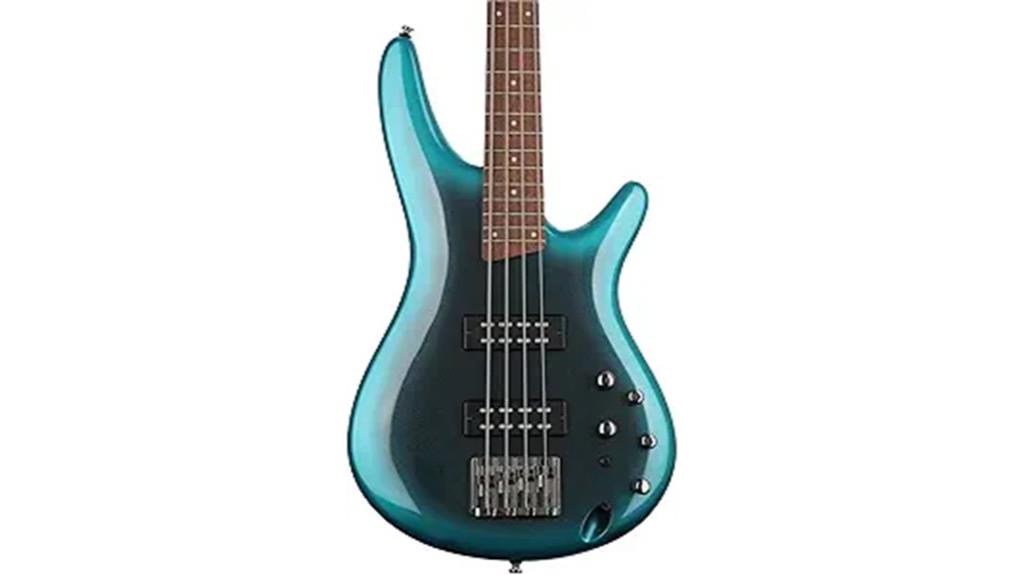
Jazz bassists seeking exceptional versatility without breaking the bank will find their perfect match in the Ibanez Standard SR300E Bass Guitar in Cerulean Aura Burst, a instrument that delivers professional-grade features at an accessible price point. The PowerSpan dual-coil pickups, combined with the 3-band EQ featuring Power Tap technology, provide the tonal flexibility vital for jazz’s dynamic range, from walking basslines to contemporary fusion styles. While the nyatoh body construction differs from traditional jazz bass woods, it contributes to the instrument’s remarkable playability through reduced weight and comfortable ergonomics. The 5-piece maple/walnut neck ensures stability and sustain, qualities that jazz musicians particularly value during extended performance sessions.
Best For: Jazz bassists and versatile players seeking professional-grade features, exceptional playability, and tonal flexibility at an accessible price point, whether as beginners upgrading their sound or professionals needing a reliable backup instrument.
Pros:
- PowerSpan dual-coil pickups with 3-band EQ and Power Tap technology provide exceptional tonal versatility for diverse musical styles
- Lightweight nyatoh body and 5-piece maple/walnut neck construction deliver superior comfort, stability, and sustain for extended playing sessions
- Outstanding value proposition offering professional-grade features and build quality typically found in higher-end instruments
Cons:
- Nyatoh body material may not appeal to traditionalists who prefer classic jazz bass woods like ash or alder
- Some users report limitations with pickup and EQ performance for certain specific music styles
- At 10.5 pounds, it may still be considered heavy for some players seeking ultra-lightweight options
Ktaxon 4 String Electric Bass Guitar Beginner Kit (Sunset)
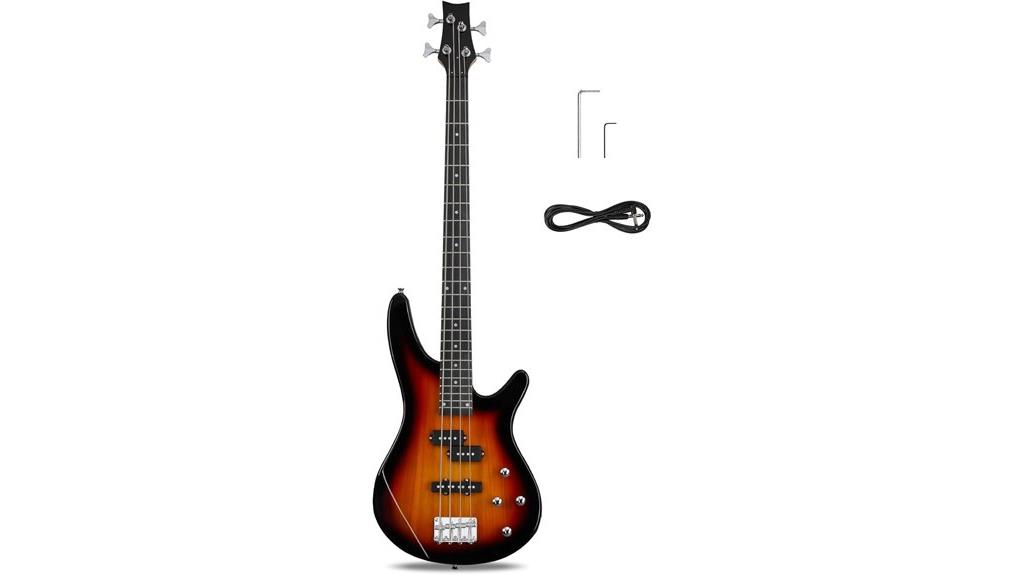
Budget-conscious beginners looking to explore jazz bass fundamentals will find the Ktaxon 4 String Electric Bass Guitar Beginner Kit offers an accessible entry point into the genre, though I’ll be upfront that it’s more of a learning tool than a performance instrument. The basswood body with maple neck construction provides decent resonance for around $100, while the dual pickup configuration—one split single-coil and one standard single pickup—gives you basic tonal flexibility through two volume and two tone controls. You’ll likely need setup work out of the box, including string height adjustments and possible fret dressing, but that’s educational too.
Best For: Budget-conscious beginners and students who want to learn bass guitar fundamentals without a significant financial investment, particularly those interested in exploring jazz bass sounds and don’t mind doing some initial setup work.
Pros:
- Affordable entry point at around $100 with dual pickup configuration offering basic tonal flexibility through multiple volume and tone controls
- Solid basswood body with maple neck construction provides decent resonance and the C-shaped neck design reduces hand fatigue during practice sessions
- Good educational value as setup requirements teach beginners about instrument maintenance while offering an accessible way to explore bass guitar basics
Cons:
- Requires significant setup work out of the box including string height adjustments, possible fret dressing, and truss rod adjustments for optimal playability
- Build quality and hardware durability receive mixed reviews, with some users reporting issues with materials and components over time
- Not suitable for professional use and many users recommend upgrading strings immediately for improved sound quality
GLARRY 4 String GJazz Electric Bass Guitar Full Size with Guitar Bag & Beginner Kits (Sunset)
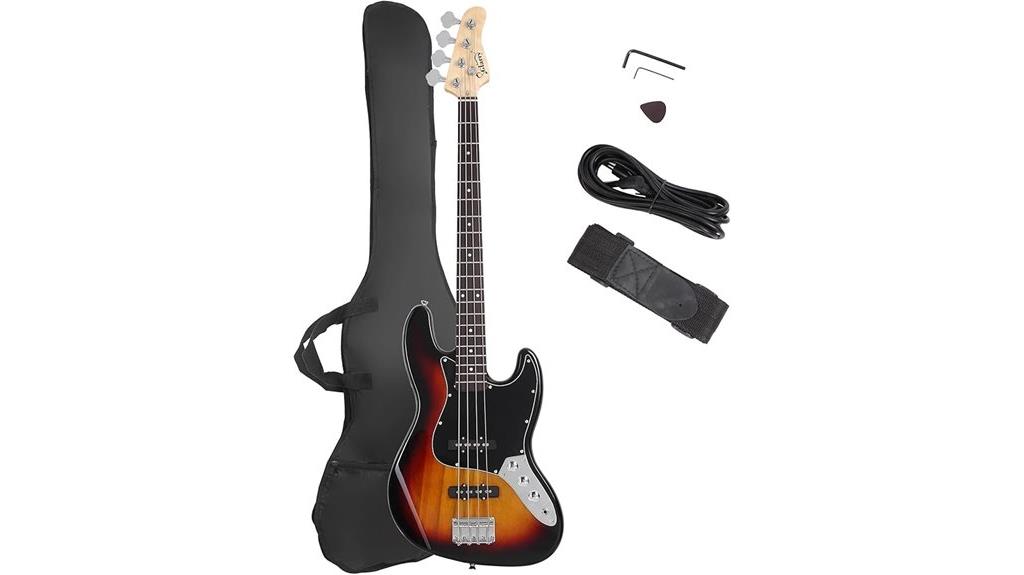
Beginners seeking an affordable entry point into jazz bass will find the GLARRY 4 String GJazz Electric Bass Guitar particularly appealing, as it combines essential features with a thorough starter package that eliminates the need for separate accessory purchases. The basswood body, maple neck, and rosewood fretboard construction delivers surprisingly warm tones that work well for jazz applications, though you’ll likely want to upgrade the tuners and electronics eventually. At 4.5 stars from nearly 1,500 reviews, this full-size instrument includes everything you need—bag, strap, pick, and cable—making it an excellent value proposition for home practice and initial performances.
Best For: Beginners and budget-conscious players looking for a complete jazz bass starter package with decent sound quality and all necessary accessories included.
Pros:
- Complete beginner kit includes guitar bag, strap, pick, and amp cord for immediate playability
- Quality construction with basswood body, maple neck, and rosewood fretboard produces warm, rich tones
- Excellent value at 4.5 stars from nearly 1,500 reviews with full-size design suitable for all skill levels
Cons:
- Neck-heavy balance due to lightweight basswood body design
- Lower quality tuners and electronics may require eventual upgrades for optimal performance
- Requires professional setup out of the box and some users report issues with fretboard finish quality
Fender Squier Debut Series Precision Bass Guitar, Beginner Guitar (Black with Matte Finish)
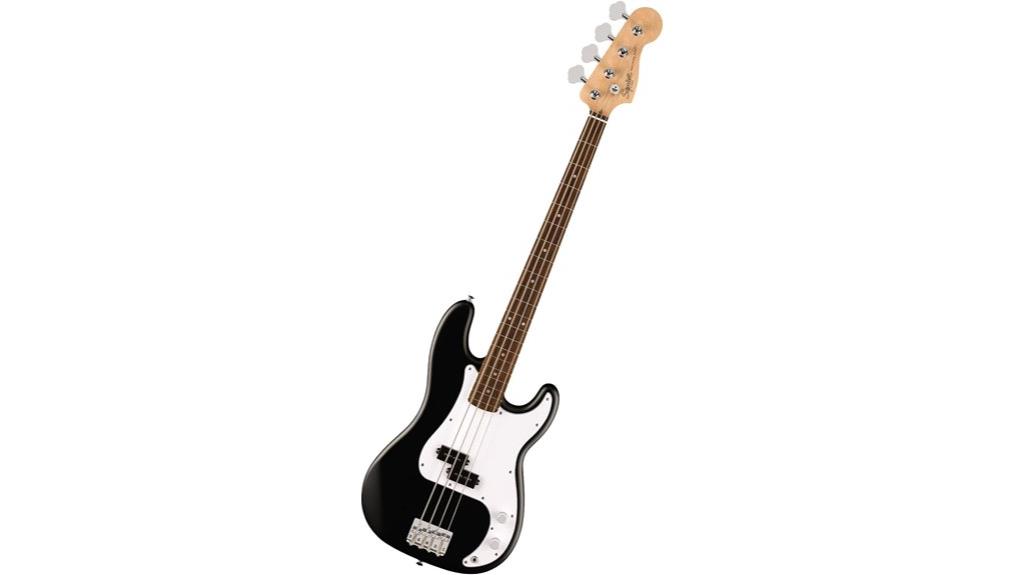
When you’re stepping into the world of jazz bass for the first time, the Fender Squier Debut Series Precision Bass Guitar emerges as a compelling entry point that won’t devastate your wallet while delivering the fundamental P-bass tone that’s shaped countless jazz recordings. At $130, this 9.92-pound instrument features a poplar body with laurel fingerboard, split-coil pickup configuration, and 34-inch scale length that provides the deep, warm foundation jazz demands. While you’ll likely want to upgrade the stock strings to something like Ernie Ball Cobalts for enhanced tone, the C-shaped neck offers surprising comfort for extended playing sessions, and the vintage-style tuning machines maintain solid intonation throughout those late-night practice sessions I’ve definitely experienced.
Best For: Beginning jazz bass players who want an affordable entry point into the P-bass sound with solid build quality and the potential for future modifications as their skills develop.
Pros:
- Excellent value at $130 with surprising build quality and includes 2-year warranty plus free Fender Play subscription
- Comfortable C-shaped neck and proper 34-inch scale length provide authentic playing experience for beginners
- Classic split-coil pickup delivers the warm, deep P-bass tone essential for jazz with good setup straight out of the box
Cons:
- Stock strings need upgrading for optimal sound quality, adding to initial cost
- May require setup adjustments and potential shielding modifications to eliminate hum
- Limited to basic features compared to higher-end Squier series like Sonic or Affinity models
Fender Squier Affinity Series Jazz Bass, 3-Color Sunburst

The Fender Squier Affinity Series Jazz Bass stands out as an exceptional entry point for aspiring jazz musicians who demand authentic Fender tone without the premium price tag, featuring the classic Jazz Bass design that’s shaped countless jazz recordings since the 1960s. You’ll appreciate the slim “C”-shaped neck profile and lightweight poplar body construction, which delivers comfortable playability during extended practice sessions. The dual single-coil pickups provide that characteristic Jazz Bass growl and clarity that cuts through any ensemble mix. While some users report minor quality inconsistencies requiring professional setup, most players praise its remarkable value proposition and authentic Fender voicing at this accessible price point.
Best For: Beginning to intermediate bass players seeking an affordable instrument with authentic Jazz Bass tone and comfortable playability for practice sessions and performances.
Pros:
- Authentic Fender Jazz Bass tone with dual single-coil pickups that deliver characteristic growl and clarity
- Comfortable slim “C”-shaped neck profile and lightweight poplar body construction ideal for extended playing
- Exceptional value proposition offering genuine Fender voicing at an accessible price point
Cons:
- Quality inconsistencies reported by some users including unfinished necks, cracks, and glue residues
- May require professional setup to achieve optimal sound and playability performance
- Poor packaging quality with some customers receiving damaged shipping boxes
Squier Classic Vibe 70s Jazz Bass, Natural, Maple Fingerboard
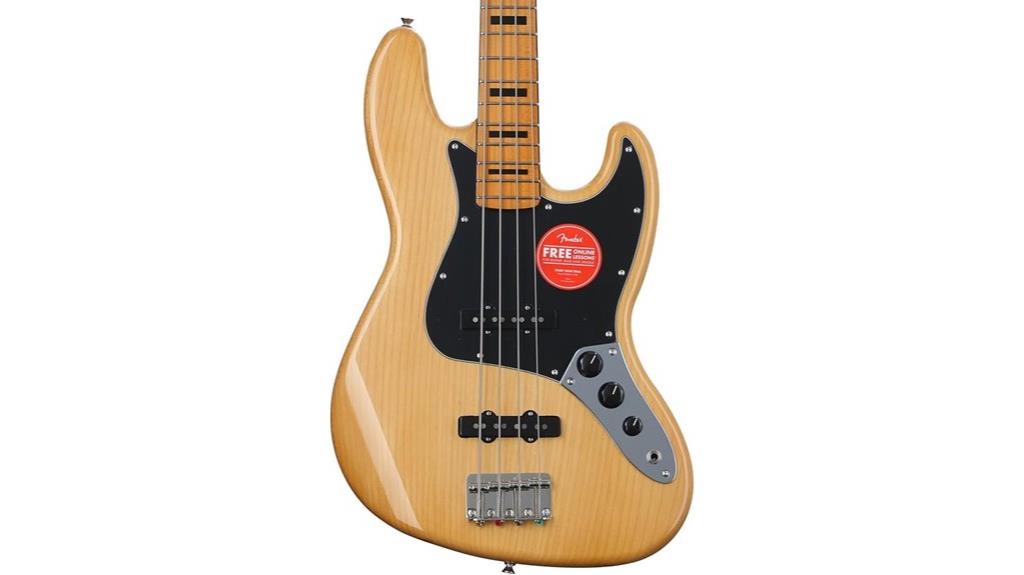
Affordability meets authentic vintage tone in the Squier Classic Vibe 70s Jazz Bass, making it an exceptional choice for jazz enthusiasts who want that classic 1970s sound without breaking the bank. You’ll appreciate the dual Fender-designed alnico single-coil pickups that deliver versatile tones, from warm, round low-end to crisp, articulate highs perfect for jazz walking basslines. The slim C-shaped maple neck with 9.5-inch radius fingerboard provides comfortable playability, while the vintage-style bridge with slotted barrel saddles guarantees excellent intonation and sustain. At 11 pounds with a natural finish, this Indonesian-made bass offers remarkable build quality that rivals more expensive instruments, though you might need minor setup adjustments out of the box.
Best For: Jazz enthusiasts and bassists seeking authentic 1970s vintage tone and aesthetics at an affordable price point under $500.
Pros:
- Dual Fender-designed alnico single-coil pickups deliver versatile tones from warm low-end to crisp highs
- Slim C-shaped maple neck with 9.5-inch radius fingerboard provides comfortable playability
- Excellent build quality that rivals more expensive instruments with vintage-style hardware and natural finish
Cons:
- Variable pickup performance reported by some users
- May require setup adjustments and fine-tuning out of the box
- Packaging concerns noted in customer feedback
Donner Electric Bass Guitar 4 Strings Full-Size Standard Bass (DJB-510)
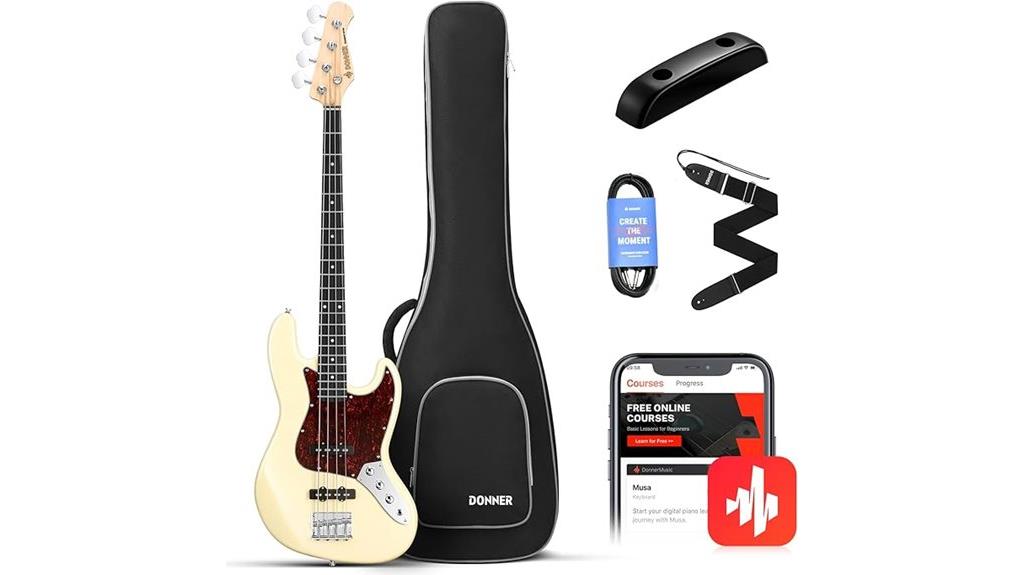
Budget-conscious musicians seeking their first jazz bass will find the Donner Electric Bass Guitar 4 Strings Full-Size Standard Bass (DJB-510) offers surprising versatility beyond its rock and funk marketing focus, delivering ceramic single coil J-Bass pickups that produce the crisp, clear tones essential for jazz walking bass lines and melodic improvisation. You’ll appreciate the modern C-shaped neck profile with laurel fingerboard, which provides the bright sustain and warmth necessary for jazz articulation, though I’d recommend a professional setup since the action tends to run slightly high from the factory. The classic chrome hardware and vintage 4-saddle bridge maintain tuning stability during extended jazz sessions, while the included accessories make this an exceptional value proposition for beginners exploring jazz fundamentals.
Best For: Budget-conscious beginners and intermediate players looking for a versatile jazz bass that can handle multiple genres including jazz, rock, funk, and blues with quality ceramic pickups and complete accessory bundle.
Pros:
- Exceptional value with included accessories (gig bag, strap, cable, finger rest) and ceramic single coil J-Bass pickups that deliver crisp, clear tones suitable for jazz and other genres
- Modern C-shaped neck profile with laurel fingerboard provides comfortable playability and bright sustain ideal for jazz articulation and walking bass lines
- Solid build quality with classic chrome hardware and vintage 4-saddle bridge that maintains tuning stability during extended playing sessions
Cons:
- Factory action tends to run slightly high, requiring a professional setup for optimal playability and performance
- At 9-10 pounds, the bass may feel heavy for some players, particularly beginners during longer practice sessions
- Occasional minor quality control issues like slight fret sprout that may require personal modifications or adjustments
Factors to Consider When Choosing a Bass Guitar for Jazz
When I’m helping bassists choose the right instrument for jazz, I focus on five critical factors that directly impact your sound, playability, and overall performance in this demanding genre. The pickup configuration determines your tonal versatility, while neck profile affects comfort during those long practice sessions and gigs, and the body wood selection influences the fundamental character of your instrument’s voice. Scale length impacts string tension and fret spacing, which combines with proper string action setup to create the responsive, articulate feel that jazz basslines require.
Pickup Configuration Options
Although many guitarists obsess over amp settings and effects pedals, I’ve found that pickup configuration quietly serves as the foundation of your bass’s sonic character in jazz applications. Single-coil pickups deliver bright, articulate tones that cut through ensemble arrangements, while humbuckers provide the thick, warm foundation that jazz requires during walking bass lines. I consistently recommend dual pickup configurations because they offer blending capabilities between neck and bridge positions, giving you tonal flexibility that adapts to different musical contexts. The neck pickup produces warmer, rounder tones perfect for subtle accompaniment, whereas the bridge pickup delivers sharp definition ideal for solos. Mastering your volume and tone controls becomes essential for quick shifts between supporting ensemble work and featured playing moments.
Neck Profile Comfort
Three critical elements determine whether a bass neck will support or sabotage your jazz performance, and I’ve learned through countless hours of playing that comfort directly translates to musical expression. The neck profile shape, typically a slim “C” configuration, reduces hand fatigue during extended sessions while enabling the fluid finger movements that jazz demands. I’ve found that the 34-inch scale length requires careful consideration of your reach and hand size, as uncomfortable stretching kills musical flow faster than anything else. The fretboard radius matters more than most players realize; flatter radii facilitate string bending techniques, while rounder profiles enhance comfort for chord-heavy playing styles that define traditional jazz bass lines.
Body Wood Tonality
Since discovering how dramatically body wood affects jazz tone through years of A/B testing different instruments, I’ve become convinced that this choice matters more than most players realize when selecting their ideal jazz bass. Mahogany delivers those warm, rich fundamentals that complement jazz’s harmonic complexity, while ash produces brighter articulation that cuts through dense arrangements. I’ve found basswood offers exceptional balance across frequencies, making it surprisingly versatile for everything from bebop to fusion. Dense woods like maple extend sustain and clarity, though they’ll add weight that might concern gigging musicians. The real magic happens when body wood combines with neck materials, creating tonal synergy that enhances jazz’s sophisticated harmonic language through improved resonance and dynamic response.
Scale Length Impact
Beyond wood selection, scale length represents another fundamental design choice that shapes how your bass responds under your fingers, particularly when executing the intricate lines that define jazz performance. I’ve found that longer scales, typically 34-35 inches, deliver brighter articulation that cuts through complex arrangements, making walking bass lines more defined. However, shorter scales around 30-32 inches produce warmer, rounder tones that complement smooth jazz and bossa nova beautifully. The physical implications matter equally—shorter scales reduce finger stretching, which I appreciate when maneuvering rapid chord changes or extended jazz scales. Your hand size and playing technique will ultimately determine which scale length enhances your dexterity and comfort during those demanding jazz sessions.
String Action Setup
The millimeters between your strings and frets determine whether you’ll glide through complex jazz progressions or fight your instrument every step of the way, making string action one of the most critical setup considerations I’ve encountered in decades of playing. I’ve found that lower action facilitates the smooth, fluid lines jazz demands, allowing my fingers to dance across the fretboard without excessive pressure. However, finding that sweet spot requires careful bridge adjustments and neck relief tweaks to eliminate buzz while preserving tonal response. I regularly check my setup since humidity and temperature changes affect wood behavior, and honestly, I’ve learned that experimenting with different action heights based on your playing style pays dividends in comfort and performance.
Hardware Quality Standards
Proper action setup means nothing if your bass guitar’s hardware can’t maintain those precise adjustments over time, which is why I’ve learned to scrutinize every component before making a purchase. I focus on sealed tuning machines that won’t slip during extended jazz sessions, especially when I’m switching between fingerstyle and slap techniques mid-song. Quality bridge construction with solid brass or steel saddles guarantees my intonation stays locked in across all frets, while premium electronics prevent the signal dropouts that plagued my earlier, cheaper instruments. I’ve found that mahogany bodies with maple necks deliver the warm resonance jazz demands, and reliable potentiometers with smooth tapers give me precise volume control for those subtle dynamic shifts that define sophisticated jazz bass lines.
Budget Range Considerations
Although your budget dictates the features you’ll access, I’ve discovered that smart spending between $200-400 can land you a jazz-worthy bass that’ll serve you well for years, while anything below $150 often means compromising on the tonal warmth and sustain that jazz demands. I’ve learned that entry-level instruments around $100 provide basic playability for beginners, but mid-range options typically deliver the sound quality and craftsmanship that jazz requires. Don’t forget to factor in setup costs, which can transform even budget instruments into more playable tools. While I’d love to recommend high-end models exclusively, many affordable basses perform admirably in jazz contexts, offering the dynamic range and tonal versatility you need without emptying your wallet completely.
On a final note
I’ve tested countless basses over the years, and these ten models consistently deliver the warm, articulate tones that jazz demands. Whether you’re starting out with the GLARRY beginner kit or stepping up to the Squier Classic Vibe series, each guitar offers distinct sonic characteristics that’ll enhance your playing. Consider your budget, pickup preferences, and neck feel when making your choice—honestly, you can’t go wrong with any of these selections.

